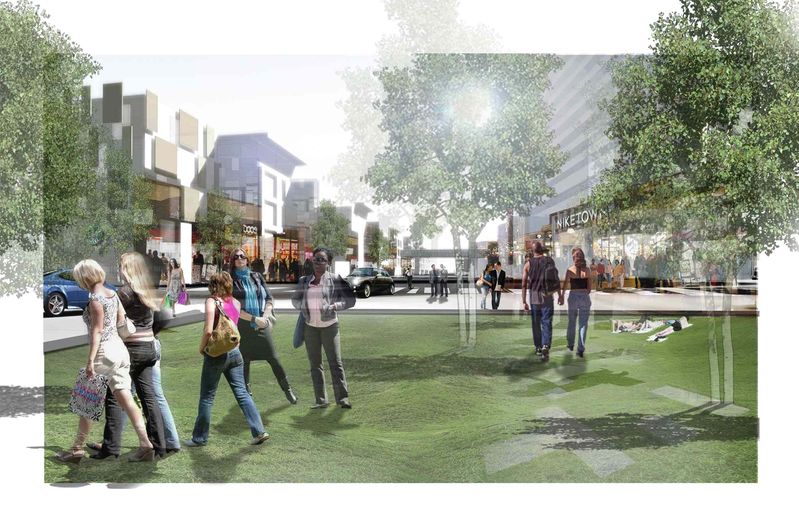By Brent Bellamy, Creative Director and Architect


Cibinel Architects' proposal for a mixed-use project at the old stadium site lost out to the Target store.
When Disneyland opened its doors in 1955, visitors experienced for the first time a stroll down Main Street U.S.A., Walt Disney's nostalgic interpretation of the central pedestrian shopping strip most North American cities and towns had grown up around.
Winnipeg's example of this high street was Portage Avenue, stretching through downtown from its famous intersection at Main Street. Anchored by Eaton's, the 10th-largest department store in the world, the avenue's shops, theatres and restaurants made it the social, retail and cultural heart of the city for more than a century.
As postwar North American cities began to expand outward with sprawling, low-density suburbs, retail development responded to this new, auto-centric lifestyle by moving away from main street into enclosed suburban shopping malls, set within large, asphalt parking lots. In 1959, Polo Park opened in Winnipeg, and the first shot was fired in the long war against downtown shopping.
The mall would reign as the king of retail for a generation, but the seeds of what would come next were planted in 1962 when the first large, suburban discount Walmart, Target and K-Mart stores opened in the United States. Decades later, retail culture would shift away from the enclosed mall and move toward big-box stores and retail power centres, a trend that is reshaping the modern North American city.
While malls typically focus on clothing sales, the big-box stores cater directly to the everyday needs of the community, with power centres serving a larger geographic area than the numerous small neighbourhood stores they have replaced. This shift in shopping habits has fundamentally reconfigured urban-development patterns, with daily errands requiring greater driving distances and cities being forced to build and maintain new infrastructure to support this increased dependence on the automobile.
According to the National Household Travel Survey, between 1990 and 2009, the average American household was driving nearly 1,600 kilometres more each year on shopping errands alone. In this time, shopping-related driving grew six times faster than driving for all other purposes, and the distance of a typical shopping trip increased by three kilometres on average. This increase has added a staggering total of 240 billion kilometres of driving on American roads each year.
The big-box development pattern has even begun to extend beyond retail with traditional neighbourhood amenities such as churches, community centres and schools removing themselves as central nodes in healthy, walkable communities and relocating to fringe locations on major roadways, intensifying automobile dependence in the life of new suburban neighbourhoods.
As the retail landscape inevitably evolves once again, power centres will leave a challenging redevelopment legacy for cities and communities. The recent announcement that Target Canada will be closing all 133 of its stores has opened a discussion about the future of these large, purpose-built structures and the parking lots that surround them.
In the United States, where diminishing returns in the power-centre model has resulted in thousands of vacant big-box buildings, recycling these mega-structures has become an important challenge in communities across the country.
While many vacant buildings are subdivided into smaller stores, or simply rebranded by a different large-format retailer, the most impactful redevelopment schemes are those that use these vacancies to repurpose big-box retail into centres for community life.
With careful planning and good design, the opportunity exists to redefine car-oriented suburbs and begin building an economically sustainable city with healthier, people-focused neighbourhoods.
Many American examples demonstrate the impact a big-box store can have, finding new life responding to the needs of the surrounding community. In McAllen, Texas, a former Walmart was transformed into the country's largest single-floor public library with high ceilings, skylights and flexible floor areas that include a computer lab, a café and a 180-seat auditorium.
In Kentucky, a Walmart was transformed into a medical facility similar to Winnipeg's Access Centres. In Buffalo, Charlotte and Phoenix, new neighbourhoods that typically surround power centres were provided with new schools through big-box redevelopment. Other successful repurposing of retail buildings for community use has included numerous examples of fitness centres, churches, seniors centres and in Austin, Minn., a vacant K-Mart was redeveloped into the Spam Museum, becoming the town's major tourist attraction, drawing 100,000 visitors annually.
The vast parking lots that surround most retail power centres provide an important opportunity to create walkable connections to the surrounding neighbourhoods through the addition of higher-density residential development. With newly converted community buildings, existing retail and an injection of a permanent population, these isolated shopping islands can be redefined into diverse, mixed-use town centres that are woven into the fabric of the surrounding community.
A proposal to create an innovative mixed-use infill neighbourhood in a Winnipeg retail area was submitted to the city in 2011 as a design for the redevelopment of the Polo Park stadium site by Cibinel Architects, in collaboration with Batteriid Architects of Iceland. Typical mixed-use retail developments often treat the residential component as an afterthought, with one or two highrise buildings surrounded by asphalt parking lots, in the least desirable corner of the site. Cibinel's imaginative proposal, established a vibrant, integrated community with shops, restaurants, offices and a hotel combined with the density of 650 residences in mid-rise buildings set along a linear network of plazas, green space and walkways. In the end, the city selected a plan without the residential component, and it is now the site of a new, but soon-to-be-vacant 107,000-square-foot Target store.
(To be fair, the plan the city selected did originally contain a residential component, however, zoning rules governing the use of land around Richardson International Airport preclude the possibility of any large-scale new residential development within the Polo Park area.)
The greatest challenge facing North American cities in the future will be the development of sustainable suburbs that reduce auto dependence and create healthier, more economically viable neighbourhoods. Prosperous cities will reverse their unmanageable growth patterns and develop a suburban model that is more compact, with higher densities and sustainable levels of infrastructure that don't strain civic budgets.
With some creativity, the immediate loss of Target stores and the inevitable long-term shift away from big-box retail should be seen as an opportunity to reclaim the suburbs and redefine suburban areas into diverse, healthy and integrated neighbourhoods.
Brent Bellamy is senior design architect for Number Ten Architectural Group.
Republished from the Winnipeg Free Press print edition March 2, 2015 B4

